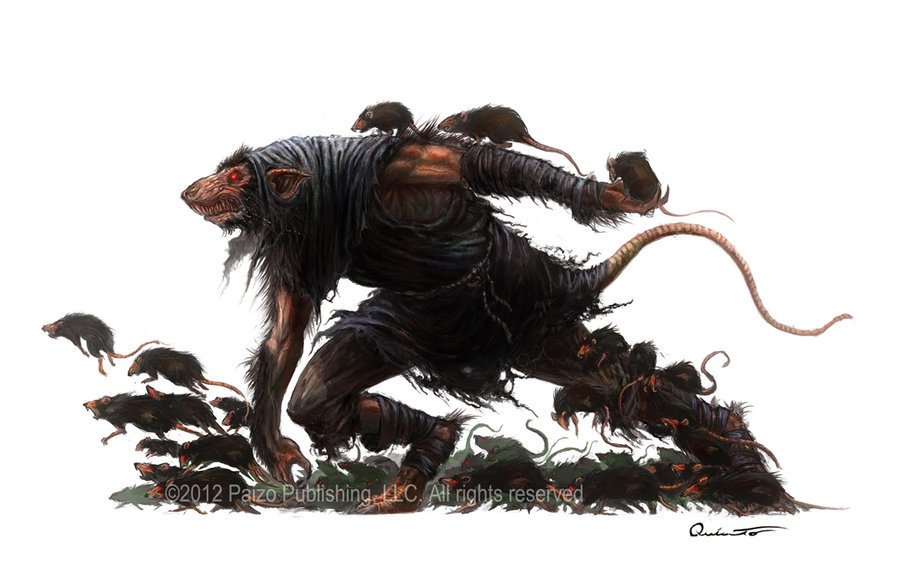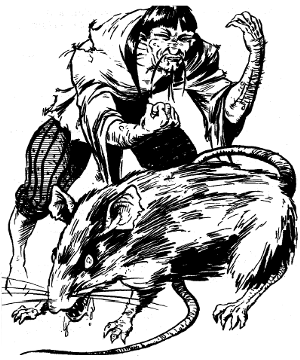There were some monsters from the AD&D Oriental Adventure book I did not convert originally because I didn’t see the point of them from an D&D ecological point of view. However, these are legitimate creatures from Japanese mythology so for complexes sake here they are.
Goblin Rat
Goblin rats live on the fringes of human settlements, stealing food and livestock and occasionally preying on lone travelers. Their lair is typically a deserted temple or abandoned hut in the forest, the inhabitants slain or driven off. They do not have a language of their own, but speak the trade language and the language of humans common to the area.
This creature is identical to the gaijin wererat but is different enough it gets its own stat block.
GOBLIN RAT
Ailurophobia. Goblin rats have a great fear of all types of feline creatures and must make a DC 10 Wisdom saving throw when faced by such a creature. Those which fail the saving throw are frightened and flee in panic, while a successful saving throw leaves the goblin rat unaffected. Cat-like creatures gain a +1 on all attack rolls and ignore the goblin rats resistences when fighting goblin rats, because of the antipathy between the two and the superstitious fear of the goblin rats. Indeed, even life-like paintings of cats are sufficient to protect a household from goblin rats.
Shapechanger. The goblin rat can use its action to polymorph between its two forms – a rat-humanoid hybrid or into a diseased giant rat. Its statistics, other than its size, are the same in each form. Any equipment it is wearing or carrying isn’t transformed. It reverts to its true hybrid form if it dies.
Keen Smell. The goblin rat has advantage on Wisdom (Perception) checks that rely on smell.
ACTIONS
Multiattack (Hybrid Form Only). The goblin rat makes two attacks, only one of which can be a bite.
Bite (Hybrid Form Only). Melee Weapon Attack: +4 to hit, reach 5 ft., one target. Hit: 4 (1d4 + 2) piercing damage. If the target is a humanoid, it must succeed on a DC 11 Constitution saving throw or contract a random disease.
Ninja-To (Hybrid Form Only). Melee Weapon Attack: +4 to hit, reach 5 ft., one target. Hit: 5 (1d6 + 2) piercing damage.
Shudo (Hand Crossbow) (Hybrid Form Only).Ranged Weapon Attack: +4 to hit, range 30/120 ft., one target. Hit: 5 (1d6 + 2) piercing damage.
DESCRIPTION
The goblin rat is a repulsive, disease-ridden shapechanger and a cousin of the hengeyokai.
Unlike the hengeyokai, the goblin rat can assume only two forms: animal and humanoid. In its animal form, it looks like a diseased giant rat, about 3 feet from nose to rump with a lean body and black or brown fur. Its hairless tail is nearly as long as its body. It has pointed ears, beady red or black eyes, and a mouth filled with sharp fangs. In its humanoid form, it appears as a ratman — a short human with a wiry body, thin moustache, greasy skin, and darting eyes.
Goblin rats do not have their own language, but they speak the trade language (common) as well as any languages common to their immediate area. They can speak only in humanoid form.
Combat
Goblin rats almost always prefer flight to combat, even when their lairs are threatened. However, when cornered or hungry, goblin rats will fight ferociously.
In either form, the goblin rat retains all its hit points and abilities. Changing forms requires an action. Armor and equipment do not change form along with the goblin rat. When changing from humanoid to animal form, all weapons and armor fall from its body to the ground.
While in animal form, a goblin rat cannot use weapons or armor. It attacks with its bite instead. Each successful hit inflicts has a chance of transmitting a disease to the victim. Cholera, plague, and fevers are the diseases most commonly transmitted.
In its ratman (humanoid) form, a goblin rat cannot inflict damage with its bite. It can use weapons and armor, however. It favors spears, naginata, and two-handed swords. For armor, it prefers studded leather and ring mail.
When 10 or more goblin rats are encountered, one of the creatures serves as king of the group. The king has maximum hit points and 15 Strength. In humanoid form, the king typically wields a two-handed sword.
The goblin rat is terrified of all cats and catlike creatures. When facing such felines, it must make a saving throw or run in fear.
Habitat/Society
Goblin rats live on the fringes of human settlements. They usually dwell in abandoned huts, deserted temples, or other buildings from which they have driven the former owners. A typical rat pack is an extended family of 1-10 adult males, an equal number of adult females (as dangerous as males), and a number of young equal to the total number of adults.
The largest male adult is the self-declared king. He maintains absolute authority over the pack. If the king is challenged by another male rat in the pack, they duel to the death in their animal forms, with the winner assuming the kingly duties.
Under the cover of night, goblin rat packs make raids into human villages to steal food and livestock. Occasionally, they also prey on lone travelers. Goblin rats hoard sizeable treasure, including coins, gems, and other shiny trinkets, which they usually bury in deep holes behind their lairs.
Ecology
Goblin rats eat whatever morsels they can scrounge. Hunting is not their forte, so they prefer easy, domisticated prey such as pigs, sheep, and horses. They also enjoy fruits and grains.
Goblin rats are symbols of cowardice and deviousness. Because of the diseases they carry, they are not considered desirable company by other creatures. Oni have been known to employ them as servants, however. The flesh of this creature is inedible. Some folk consider the whiskers to be an effective cure for baldness, and create a tonic by boiling the whiskers in water.
Banner Art Credit: Paizo, Crimson Throne.
Insert Art Credit: TSR/WoTC.

